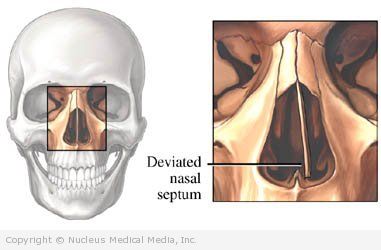Deviated nasal septum
(Deviated Septum)
Deviated nasal septum – Definition
The nasal septum is the wall that separates the left and right nostrils. A centered septum allows air to flow equally through each nostril. In a deviated nasal septum the wall is not centered.
A deviated septum may cause no symptoms at all. In severe cases, airflow through one or both nostrils may be blocked. A blocked nostril may cause chronic stuffiness and a tendency to get sinus infections.
Deviated nasal septum – Causes
Causes include:
- Present at birth — arose during fetal development (5% of cases)
- Birth injury to the nose
- A blow to the nose, often during an accident or while playing sports
Deviated nasal septum – Risk Factors
Risk factors include:
- Contact sports, especially karate or football without appropriate protective headgear
- Trauma is the most common risk factor
Deviated nasal septum – Symptoms
Symptoms include:
- Stuffy nose (one or both sides)
- Sinus infections
- Nosebleeds
- Breathing noisily during sleep
- Facial pain or headache
Deviated nasal septum – Diagnosis
The doctor will ask about your symptoms and medical history. A physical exam will be done. The doctor will examine the nasal passages. A nasal speculum will hold the nose open. A thin telescope is passed into the nose.
Deviated nasal septum – Treatment
Most people will not require treatment. In severe cases, surgery may be needed. Surgery on the septum alone is called septoplasty. It relieves nasal blockage by centering the septum between the two nostrils.
Sometimes surgery to reshape the nose ( rhinoplasty) is performed at the same time. The two procedures together are called septorhinoplasty. Children who need surgery usually wait until they’ve stopped growing, around age 16.
Deviated nasal septum – Prevention
To help prevent a deviated septum:
- Wear seat belts in automobiles and airplanes
- Wear appropriate protective headgear when playing sports

